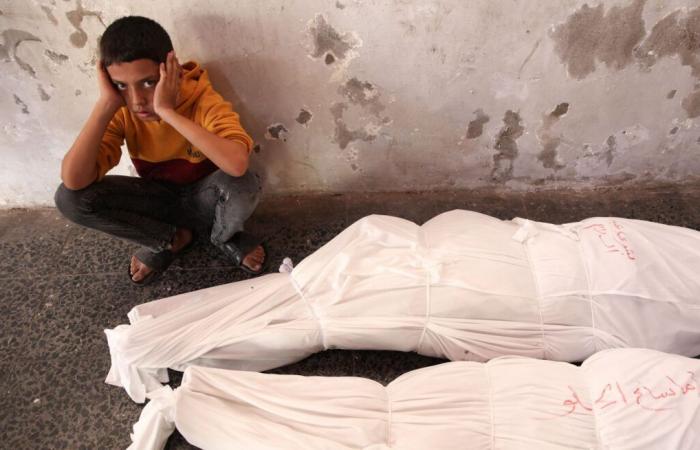
Israeli Prime Minister Benjamin Netanyahu met on Thursday with American envoys who came to Israel to move towards a ceasefire in Lebanon, stressing that a truce with Hezbollah must guarantee the security of his country.
This visit to Jerusalem by White House emissaries Amos Hochstein and Brett McGurk aims to end more than a month of war between Israel and the Lebanese Islamist movement supported by Iran, while the United States tries to reach a framework agreement a few days before the presidential election.
The head of American diplomacy, Antony Blinken, affirmed in the evening that the discussions had “progressed well”. “We still have work to do,” he added, calling for “a diplomatic solution, including via a ceasefire.”
On Thursday, rocket fire from Lebanon killed seven people in northern Israel and the Israeli army carried out strikes in Lebanon and the Gaza Strip, where it has been at war for more than a year against the Palestinian Hamas, an ally of Hezbollah.
According to Israeli media citing government sources, the plan drawn up by American mediators provides for a withdrawal of Hezbollah from southern Lebanon, bordering Israel, as well as the withdrawal of the Israeli army from this region, control of which would return to the Lebanese army and UN peacekeepers.
Lebanon would have the responsibility to prevent Hezbollah from rearming with imported weapons and Israel would retain its right to defend itself in accordance with international law.
Mr. Blinken once again called for the full implementation of United Nations Security Council Resolution 1701, which ended the previous war between Hezbollah and Israel in 2006 and under which only peacekeepers and the army Lebanese forces must be deployed in southern Lebanon.
“The main issue […] is Israel’s ability and determination to enforce the agreement and prevent any threat to its security from Lebanon,” Mr. Netanyahu told the American envoys, according to his office.
Later, the Prime Minister assured that he “appreciated” American support, while refusing to give in to pressure from his historic ally.
“Terrorist armies will no longer be at our borders. Hamas will no longer control Gaza and Hezbollah will not establish itself on our northern border in positions allowing it to invade Israel, he said.
“Total dismantling”
Israel says it wants to neutralize Hezbollah in southern Lebanon to allow the return of some 60,000 residents of northern Israel displaced by incessant rocket fire since the start of the war in Gaza.
According to Israeli channel 12, Israel demands the withdrawal of Hezbollah north of the Litani River, about thirty kilometers north of the Israeli border, the deployment of the Lebanese army on the border, an international mechanism for applying the truce and the guarantee that Israel will retain its freedom of action in the event of threats.
Israeli officials also said that soldiers engaged in a ground offensive in southern Lebanon since September 30 would not withdraw until an agreement that meets Israel’s security requirements.
On Wednesday, the new leader of Hezbollah, Naïm Qassem, said he was ready for a ceasefire “under conditions”, without specifying which ones.
According to Israeli media, a ceasefire appears more and more likely, after the Israeli chief of staff, General Herzi Halevi, reported the “total dismantling of the chain of command” of the Hezbollah.
The war that has been raging since October 7, 2023 in the Gaza Strip spread more than a month ago to Lebanon, where Israel has been carrying out strikes since September 23 mainly on Hezbollah strongholds in the south and the east of the country, and on the southern suburbs of Beirut.
On Thursday, six rescue workers affiliated with Hezbollah and its ally Amal were killed in Israeli raids in southern Lebanon, according to Lebanese authorities. Bombings also targeted the outskirts of the southern city of Tire and the area around Baalbeck in the east.
At least 1,829 people have been killed since September 23 in Lebanon, according to an AFP count based on official data.
Refusal of a “temporary truce”
In the Gaza Strip, the Israeli army has mainly concentrated its deadly offensive in the north since October 6, where Hamas is seeking to regroup its forces, according to it.
According to the US State Department, the visit of US envoys to Jerusalem on Thursday also focused on “ways to end the conflict in Gaza”.
A Hamas official, Taher al-Nounou, reiterated on Wednesday his movement’s refusal of a “temporary truce”, after the announcement by a source close to the negotiations that the mediating countries, Egypt, the United States and Qatar, were preparing to propose a truce “of less than a month” in the Palestinian territory.
Antony Blinken also urged Israel on Thursday to “urgently” allow the resumption of the polio vaccination campaign in Gaza, particularly in the north, interrupted after intensive bombings.
The war was triggered on October 7, 2023 by the unprecedented attack carried out by Hamas against Israel, which resulted in the deaths of 1,206 people, mostly civilians, according to an AFP count based on official Israeli data, including hostages killed or died in captivity.
Of 251 people kidnapped, 97 remain hostages in Gaza, 34 of whom were declared dead by the Israeli army.
The retaliatory offensive by Israel in Gaza left 43,204 dead, mostly civilians, according to data from the Hamas government’s Ministry of Health, deemed reliable by the UN.





